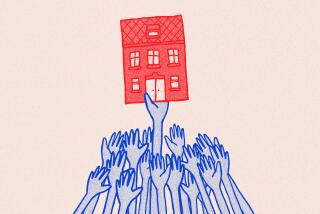The Screen-Eyed Monster
- Share via
At first he was simply Big TV Man.
He lived in the tower across the street, 10th floor. Come nightfall, his 9-foot living-room wall would be swallowed by massive, flickering blue images. My dinner guests would stop their conversation midsentence and just stare across the divide into his picture window, mesmerized.
The women wondered if Big TV Man was rich. The guys cracked jokes to mask feelings of inadequacy. My jealous boyfriend took to aiming a red laser pointer into Big TV Man’s Swinging Digital Den, smirking whenever our neighbor was jolted from the reverie of his massive projection system.
My comrades, like so many other Americans, had been gripped by screen envy. Nagging gremlins of inferiority would cling to the bases of their brains until they too got a big screen.
Silly? Perhaps. Real? You bet; experts call screen envy a genuine social phenomenon that is on the rise from New Jersey to the far side of the Pacific. Today’s 57-inch TV carries the same social clout the hottest hot rod did in the 1950s or the biggest stereo in the 1970s. It’s that must-have item that, many feel, separates the hip from the hopeless.
“The guys who were first part of the cassette-tape generation are in their 30s and 40s, and now have the homes to replace their cars as their primary location for entertaining,” says Guy Primus, vice president of Blue Flame Marketing and Advertising in New York. “The same guys that wanted the fastest car 20 or 30 years ago want the biggest and best home entertainment system now.”
Psychologists and marketers say screen envy happens like this: The owner of a mega-inch TV is happily minding his own business until his--and it’s usually a “his”--best friend gets a mega-plus-1-inch. Next time there’s a basketball game, the party moves to the home of the newly anointed altar of viewing pleasure. The onetime alpha male of the entertaining pack becomes the beta, and screen envy is planted.
“I had a 25-inch TV for a while, and then my buddy got a 32-inch TV, and that was it. It’s been a competition from there,” says Mike Surbrug, a stockbroker in Roselle Park, N.J. “Right after that, my TV broke, and I got a 35-inch.... I thought, ‘I have the biggest TV.’ ” Until another buddy bought a 36-inch weeks later. Overnight, Surbrug’s inadequate diagonal count became the butt of jokes. Then, within another few weeks, Surbrug’s roommate trumped everybody by getting a $3,000, 57-inch behemoth.
Detente. For now.
“Guys just want to perfect their dream entertainment centers, I guess,” Surbrug says. “I am not done at all.”
Michael Nuccitelli, a psychologist and the executive director of SLSHealth.com, a wellness clinic in Brewster, N.Y., says Surbrug’s experience is indicative that new status symbols have arrived along with the new millennium. “A big-screen TV is a sign of material wealth and is an ego boost” for this generation, Nuccitelli says.
The widespread introduction of flat-screen in the late 1990s meant that, for the first time, videophiles no longer had to choose between floor space and screen size. Big-screen and high-definition TVs are expected to exceed $8 billion in sales this year, according to the Consumer Electronics Assn.
Additionally, surging growth in DVD technology is fueling new excuses to buy a TV that can handle a wide-screen format. Sales in DVD players--as expensive as $500 five years ago but now as little as $100 in discount stores--are growing by double-digit percentages, while VCR sales have been falling slightly, according to April data from the association.
No one knows the identity of screen envy’s Patient Zero. But chances are it was a sports fan. Increasingly, towns with top-performing teams--Lakers-loving Los Angeles included--are being linked with upswings in big-screen sales.
TV retailers in Indiana say big screens sell faster every time the Hoosiers make the Final Four. And Hanoi retailers, in advance of this year’s World Cup, experienced a similar blip in big-screen demand, the Vietnam News Agency reported. Vietnamese employers even bought big screens to keep the staffs from calling in sick to watch the matches.
“When Jerome Bettis runs over a defensive back, we want to see the slobber fly out of the poor guy’s mouth and his eyes roll back in his head,” says ad exec Primus. “Having a giant TV is the next best thing to being on the field in uniform--and a lot safer.”
But there’s a high price to succumbing to screen envy, literally. Screen-envy victims rarely get away with a fix for less than $1,200.
Los Angeles resident Brill Bundy knows that well. The rare female victim of the syndrome, Bundy is managing editor of TV coverage for Zap2It.com, a Web site owned by The Times’ parent company, Tribune Co.
Bundy fights her condition, refusing to buy a screen bigger than her current 33-incher. Instead, she says, she gets her fix by peeping into people’s windows around her Fairfax neighborhood, noting who has bigger diagonals.
“I’ve never been caught,” Bundy says. “I’m never that obvious. I’ll maybe stop, catch a few minutes of ‘Sex and the City,’ and move on.”
Bundy traces her condition back two years, when she first moved to Los Angeles from Texas where her 33 inches did her proud. Back in the Lone Star State, she insists, “nobody else had big TVs.”
Other victims betray their condition through their wallets. Take John McGann, who told his wife last year he would only move the family from Venice Beach if he could have a pool and a 57-inch TV.
Turns out, he paid more for that TV--$10,500--than he did to furnish the new home--$7,000. And guess which item arrived at the house first? “I had this massive TV, and there was not a stick of furniture in the new house,” says McGann, a real-estate appraiser who moved to Westchester in November.
Wouldn’t that money have been useful for his retirement? “Oh, I’m 56,” McGann says. “I’ve got plenty of time for that.”
One more symptom of screen envy: loss of ability to communicate. “Why did I want this TV?” McGann repeats a question. “I just wanted it.”
Which brings us back to Big TV Man, King of Los Angeles, or, at least, ruling demigod of any TV lovers who live in my Park La Brea apartment complex. Big TV Man is actually Ryan Snyder, a very forgiving urban planner who let me see his projection system even after I confessed about the laser pointer.
He insists that having a big screen “has never been really important to me.” Easily said, given that Snyder’s projection system, rigged through a healthy-sized TV that also sits in the living room, registers him immune from screen envy. His digital projector can make images as big or as small as he wants.
Now all he needs is to sell tickets and popcorn.
More to Read
The complete guide to home viewing
Get Screen Gab for everything about the TV shows and streaming movies everyone’s talking about.
You may occasionally receive promotional content from the Los Angeles Times.





